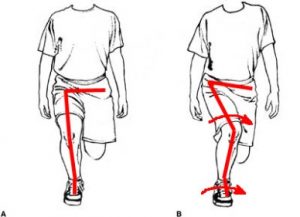Patellofemoral pain, also known as runners knee and movie goer’s knee is one of the most common knee complaints seen in physio clinics. It is felt behind and around the kneecap and is due to irritation between the kneecap (patella) and the underlying groove of the thighbone (femur) and it can often be from overuse of the knee or mal-alignment of the patella in the groove.
The patella slides in the groove of the femur and is held in place by the quadriceps muscles and tendons attached to the inside and outside edges of the patella. The function of the patella is to increase the force of the quadriceps thigh muscles as the knee bends or straightens under load. The patellofemoral joint is subjected to loads many times the body weight when loaded in knee flexion. This can range from 0.5 times body weight with walking to seven or eight times body weight on stairs.
 Pain is thus often felt with walking, running, jumping, on stairs, squatting and prolonged sitting (movie goer’s knee) activities and can be accompanied by grinding or clicking noises, a sensation of weakness, giving way and swelling.
Pain is thus often felt with walking, running, jumping, on stairs, squatting and prolonged sitting (movie goer’s knee) activities and can be accompanied by grinding or clicking noises, a sensation of weakness, giving way and swelling.
There are many factors that can cause alignment changes of the patella in relation to the femur. This will affect the smooth gliding of the patella, causing irritation and possibly damaging the under surface of the patella if left untreated.
Some of the factors that may predispose to this condition include;
- Tight muscles and tendons attached to the outside edge of the patella
- Weak or inactive muscles attached to the inside edge of the patella
- Extremes of foot posture i.e. pronation
- Mal-alignment of the knee joint
- A patella that sits abnormally high or low
- Tight calf, hamstrings, quadriceps or hip muscles
- Poor pelvic stability, knee control and balance
 A – normal alignment B – unlevel pelvis, increased hip internal rotation and adduction, with inwardly rotating femur
A – normal alignment B – unlevel pelvis, increased hip internal rotation and adduction, with inwardly rotating femur
Treatment can last from weeks to months depending on the severity and will involve correcting the predisposing factors
Treatment may include;
- Activity modification to reduce any irritation to the patella
- Ice for swelling and pain control
- Taping or brace to correct patella alignment
- Orthotics
- Deep tissue massage
- Stretches and foam roller
- Quadriceps and hip strengthening exercises
- Exercise to improve pelvic stability, knee control and balance
